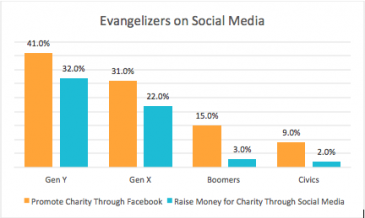Social Media Lessons from 4 Generations of Canadian Donors

Social media may seem like the way to reach the next generation of donors. But, can you really raise money through social networks?
Social media has already shown that it is paying off for many nonprofits, but in a new way – not through direct gifts, but by deepening relationships with supporters, by empowering evangelists and much more.
Let’s dig deeper, shall we?
Social Media Generation Profiles
hjc, Blackbaud, Edge Research, and Sea Change Strategies recently studied the giving habits and communication preferences of four generations of Canadian donors and published findings in a report called The Next Generation of Canadian Giving 2013. The study, which builds on a similar study conducted in 2010, looked at the philanthropic habits of the following generations of Canadians:
- Generation Y (or Gen Y, born 1981 – 1995)
- Generation X (or Gen X, born 1965 – 1980)
- Baby Boomers (or Boomers, born 1946 – 64)
- Civics (born 1945 or earlier)
Some interesting and helpful data emerged, including some specific information about how each generation approaches social networks. Here are some highlights:
Gen Y:
- Gen Y is the most active on social networks
- Have the highest increase in engagement through photo streaming sites: 41% on Instagram and 22% on Flickr
- LinkedIn use rose 24% from our 2010 study to 48% in 2013
- Twitter use increased by 20% from our 2010 study to 59%
Gen X:
- Second most active social network users
- 18% are involved with non-profits through social media
- Highly Active on YouTube (95%)
- LinkedIn use surged by 37% since our 2010 study to 60%
- Twitter use increased by 20% since 2010 to 47%
Boomers:
- Boomers are more careful on networks they join and networks to participate
- 80% are active through YouTube
- Engagement through Facebook dropped slightly to 65%
- LinkedIn engagement increased by 21% since 2010 to 40%
Civics:
- Civics are using social networks, but not as much as other generations
- Are the only generation to be more active on Facebook (64%) than on YouTube (61%)
- Facebook use increased by nearly 12% since 2010 to 64%
- YouTube engagement increased by 15% since our 2010 study to 61%
- Use of LinkedIn rose by 17% since 2010 study – a quarter of Civics are present on LinkedIn (25%)
Using Social Networks for Engagement
We asked donors how important they feel that social media is. 8% report that social media is a very important touch point with the organizations they support. This is actually a slight decline from 2010, when this number was 12.5%, however social media usage continues to grow and expand; with all generations of Canadians trying new platforms and staying loyal to the systems they were already on.
Videos posted by charity or charity supporters are one of the largest opportunities for future engagement, with 27% of donors being interested in connecting through this channel. If you do not currently have a video strategy, now may be the time to create one. Videos not only let you tell the story of what your organization does, but they are window into the impact of your work.
Similar to video is imagery. One in four donors identified photo streams as future methods for engaging with nonprofits. 16% of donors are interested in using Pinterest to pin images from the charities they support in the future. Seeing your impact through imagery resonates particularly well with younger generations — more than a third of Gen Y would like to engage with charities through photo streams, and a quarter would pin something about your charity. Ensure you have a “Pin it” button on images on your website, making your visuals easy to share on Pinterest.
There are numerous of charities with examples in these types of networks. Take a look at Calgary Zoo’s 2012 Annual report shared on Instagram. To view engaging sharable Pinterest boards, check out the Canadian Cancer Society and Plan Canada.
Social Networks for Evangelizing
Fundraisers may not value “shares” and “likes” as much as donations, but evangelizers for your cause are essential. Here are some of the key findings on social networks for evangelizing:
- More than half of Canadian donors are comfortable telling others about the causes they support. Some
- Captivating messaging has motivated 23% to promote a charity cause on social networks.
- 41% of Gen Y and 31% of Gen X regularly promote causes and charities on social media
Giving on Social Networks
Though social networks are an attractive space to build engagement, the reality is that giving through social networks is very low. The good news, though, is that there is a correlation between engagement and giving.
Younger generations have higher engagement through social media and also have the highest percentage of giving through these channels. 6% of Gen Y and 4% of Gen X have made a donation through social media in the 12 months.
Understanding the networks and activities where donors will willingly engage with charities in the future is an important element to understanding where to focus your social media efforts. While giving directly through social networks isn’t that significant, high numbers (the majority of your file) use some kind of social media. They want to use social media with the charities they support, too.
Key Takeaways
Social media philanthropy won’t be replacing traditional forms of fundraising in the near future. But, it has grown as an important means of donor engagement. Donors want to know how their money is being spent, who they are helping, and what you do — and the fastest way to spread this information is through social networks.
If you are struggling to choose which social networks to invest in, know that there is no right or wrong answer. The level and particular activities chosen for engagement depends on your cause, your content, and your audience. If you have great imagery – show it off on Instagram and Pinterest. If your audience is primarily older, Facebook, YouTube and LinkedIn will be good fits for you.
Find out more about social media and the next generation of Canadian donors in the full report at: http://www.hjcnewmedia.com/nextgencanadiangiving2013/
by Michael Johnston, President and Founder, Hewitt and Johnston Consultants (hjc)
Michael Johnston is the president and founder of the global fundraising consultancy, Hewitt and Johnston Consultants (hjc), which has offices in Los Angeles, Vancouver, Toronto, and Cordoba. Michael also is founder of the UK-based fundraising firm Xtraordinary, and the co-founder of two global fundraising products, The Global Legacy Giving Group and the sports-based Fantasy Fundraising. He has helped raised over a billion dollars for his clients.
